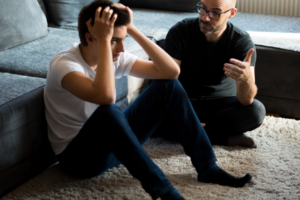Depression and Anxiety in Student Populations: Interview with Dr. Daniel Zamir
Dr. Daniel Zamir, former Student Counselor at UCLA, addresses the issues of depression and anxiety in the student population.
ADDRESSING DEPRESSION IN THE STUDENT POPULATION
The following transcript contains part of an exclusive interview with the Editor of PsychAlive and Dr. Daniel Zamir.
Dr. Daniel Zamir: I think it’s really individual to the person in terms of what I would recommend. I tend to early on do a lot more listening than recommending really, anything. Because the first step I think is about me really coming to understand the person and how they think about the world, kind of through their point of view. Because before giving anybody any advice, I really need to have an understanding of their values and the things that kind of motivate them to do the things they’re doing now. And then once I have that better understanding, I can help them to look at if there are behaviors or things they’re doing that contribute to the problems they’re having.
So I think about like with depression, for example, when people are feeling depressed regardless of what the cause, kind of the initial cause of the depression, people tend to do a lot of things that make depression worse. So they isolate themselves, they maybe won’t talk to friends or family as much because they feel like they’re burdening people, which is part of the depression, this feeling kind of worthless, or like you’re a burden on others. People will also, you know, sleep more, which is part of the depression, just kind of a need for more sleep. They’ll change their eating habits, either not eating enough or eating more than they usually would. And just kind of retreating from their life. They stop doing the things that they used to enjoy.
So with depression there’s often this kind of blunting of affect so you don’t feel the highs as much as you used to. So let’s say you used to really love playing volleyball. Now, suddenly, when you play volleyball, you don’t get that same excitement that you used to and so it’s like, “Oh, I don’t like volleyball anymore so I won’t do that.” So people start losing aspects of their lives that used to be really important. And so, often times the work is really about engaging people back in their lives. And doing things that they used to enjoy and that have been helpful in the past, even if they don’t feel that way in the moment, because it’s blunted from the depression. But having them play volleyball not less, but more, because they need to kind of counteract this, the depression. Returning to, kind of, engaging socially, talking to close friends about what they’re going through.
And with that, often times I hear people, part of the voices that people have is this idea of, “I’m burdening somebody if I talk to them about my emotional experience,” especially if it’s negative. And really, the research shows and what I find once I ask people to explore this with me is that people who are close to you, people who care about you don’t feel burdened by hearing your emotional experience. They actually feel deeply connected and they feel… useful. And it makes them feel good about themselves to be able to offer something to you, it’s almost always the case. And if there’s somebody in your life who doesn’t feel that way, that’s an issue with them, not with you.
And so I really encourage people to talk and I use this example. Like if hearing somebody’s negative emotional experience was really depressing and kind of felt like a burden, I’d be the most miserable person in the world. And I don’t think that’s the case. This would be an awful profession, if that was the case. But I feel really kind of invigorated and happy to be able to offer that to people, and especially people who are close to you. And your friends and family will usually feel that same way. So I try to kind of undermine that voice that encourages the depression and the isolation, which is that, “ I’m going to burden others by being depressed, by talking about this.”
So really, you know, it’s about engaging more in their lives, being more physically active, doing the things that are going to help them feel better, even if it’s not, you know, immediate or a quick fix. That’s often what’s kind of most useful for people. So both the cognitive part about undermining these really self-critical beliefs and the behavioral piece about actually taking actions to be more fully engaged in their lives.
ADDRESSING ANXIETY IN THE STUDENT POPULATION
The following transcript contains part of an exclusive interview with the Editor of PsychAlive and Dr. Daniel Zamir.
Dr. Daniel Zamir: With anxiety, it works pretty similarly, I would say. So, again, it’s about challenging kind of maybe catastrophic beliefs or, you know, negative assumptions about the future, which is often what happens with anxiety. People have a thought that something’s really scary and something bad is going to happen. So starting to challenge that, starting to record how often their predictions actually come true to undermine, you know, this self-critical– or the negative thoughts that come up for people, and then having them really engage with the things that they retreat from.
Again, so if it’s in social anxiety, it’s about having people try different things out socially and doing it, like I said, in a systematic way where it starts out with something that feels manageable and then it moves into kind of more and more challenging things as they get more fortified to approach. And I think that’s true with most, with most forms of anxiety, and depression. That it’s really about starting to challenge either the depressive thoughts or the anxious thoughts through action. And people, once they are able to engage in the actions that are dis-confirming those thoughts about how people respond or about, you know, what’s going to happen, that’s really powerful for people.
That’s sometimes kind of an ‘aha moment’ that, “I can go into this situation and have a different and better outcome than I expected.” First of all, it’s not just me telling then that that’s going to happen. It’s them actually having that felt experience, which is so much more powerful and it tends to excite people. And then there’s this, “Oh, my gosh! If this isn’t the way I thought it was, maybe I’ll approach this even more difficult situation and, you know, if, with social anxiety, if I can go out into just the Bruin Walk at UCLA and just be surrounded by people and tolerate the anxiety that I experience, OK, maybe I can go up and talk to this person in my class and, you know, maybe I can go and join this group that is something I’m interested in or this intramural sports team and get engaged and people just become more and more able to tolerate these difficult experiences.
And with each experience the self-critical thought process is more and more undermined, because they have some real information about how people respond to them and what they’re able to do and tolerate that goes against what they previously told themselves.
So it kind of reverses that the self-perpetuating cycle of depression of like, “ I feel bad and so I isolate and so I feel worse.” Or anxiety, which is, “I’m afraid of this and so I avoid it and I feel better so I avoid it more in the future.” Once they start approaching their lives, it really undermines [this] it and creates this positive cycle of, “I approached the thing I was afraid of and it’s not as bad as I thought and so I feel a little bit better and so I want to approach more and I want to engage more and I want to be, I want to have a more rich and full life and be a person out there in the world instead of somebody who’s retreating into myself.”
Tags: anxiety, depression, studentsOne Comment
Leave a Reply
You must be logged in to post a comment.










great and very informative thank you.